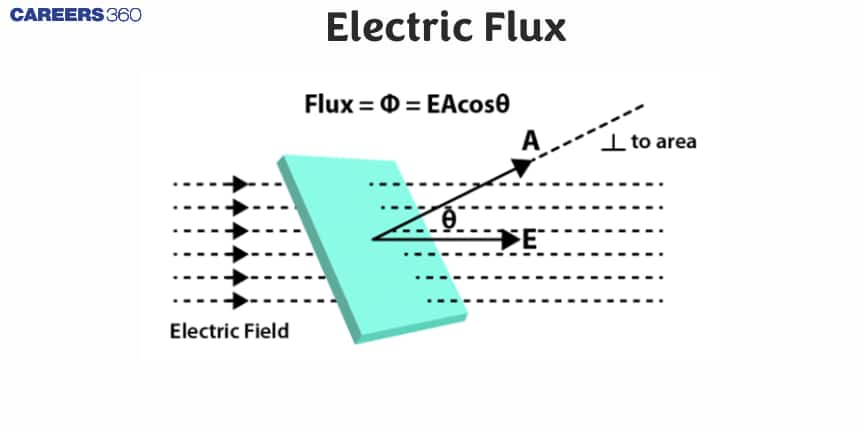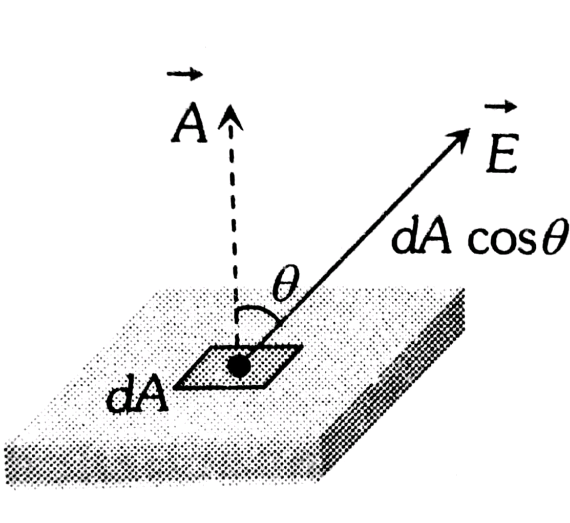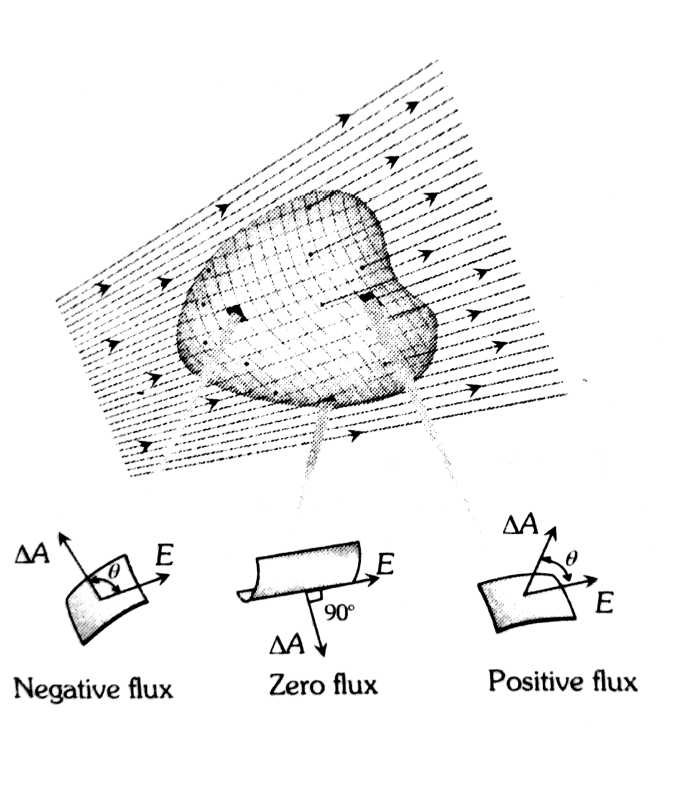Electric Flux - Definition, Formula, FAQs
Electric flux tells us how much of an electric field passes through a given area. It is an important idea in electromagnetism because it helps us understand how electric fields interact with surfaces. In JEE Main exams (2013–2023), almost nine questions have been asked from this topic, which shows its importance. In this article, we will learn about electric flux for Class 12, its symbol, the formula, important properties, Gauss’s law, its SI unit, dimensional formula, and the uses of electric flux. This will make the concept easy to understand and apply in problems.
This Story also Contains
- What is Electric Flux Class 12?
- Electric Flux Formula
- SI Unit of Electric Flux and Dimensional Formula
- What are the properties of electric flux?
- Electric Flux Density
- Gauss Law
- Uses of Electric Flux
- Solved Examples Based on Electric Flux

Also, read
What is Electric Flux Class 12?
Electric flux definition: Electric flux is the rate of flow of electric lines of force across a particular area chosen as a surface.
Let us consider an electric field that is uniform in both magnitude and direction. Let these field lines penetrate a rectangular surface of area A whose plane is oriented perpendicular to the field lines. The number of electric field lines per unit area is proportional to the magnitude of the electric field. So the total number of lines penetrating is proportional to $E.A$.
The symbol of electric flux is the Greek letter phi with subscript $E$. So electric flux symbol is $\Phi_E$.
Electric Flux Formula
The magnitude of this product is known as Electric flux, which is denoted by
$\phi_E=E A$
So,
The electric flux through an area is the number of electric field lines passing normally through the area.

The formula of electric flux through an area, dA is given by
$d \phi=\vec{E} \cdot \vec{d} A=E d A \cos \theta$
here, $\theta$ is the angle between the area vector and the electric field.
Total flux through area A is
$\phi=\int \vec{E} \cdot \vec{d} A$
SI Unit of Electric Flux and Dimensional Formula
Flux is a scalar quantity so they can be added algebraically.
The SI unit of electric flux is newton meter squared per coulomb $\left(\mathrm{N} \cdot \mathrm{m}^2 / \mathrm{C}\right)$ and volt meter $(\mathrm{V} \cdot \mathrm{m})$
Dimensional Formula
$E$ (electric field) has the dimensional formula $\left[M^1 L^1 T^{-3} I^{-1}\right]$.
$A$ (area) has the dimensional formula $\left[L^2\right]$.
Electric flux= $\mathbf{E} \cdot \mathbf{A}$
$\Phi_E=\left[M^1 L^1 T^{-3} I^{-1}\right] \times\left[L^2\right]$
thus dimension of electric flux are $\left[M^1 L^3 T^{-3} I^{-1}\right]$
|
Related Topics, |
What are the properties of electric flux?
- The electric flux is dependent on the strength of the electric field and the field passing area.
- The flux is maximum at an angle $\theta=0^{\circ}$ ( the field lines are perpendicular to the surface)
- The flux is minimum (zero) at an angle $\theta=90^{\circ}$ ( the field lines are parallel to the surface)
- If the field lines are pointed outwards from the surface then the electric flux is positive. If they are pointed inward to the surface, the electric flux is negative.
- The total flux through a closed surface with no net charge is zero.
Electric Flux Density
Electric flux density is the amount of flux passing through a unit area in an electric field. Electric flux density is also called an electric displacement field. It is given as,
$$
\mathbf{D}=\epsilon \mathbf{E}
$$
where,
- D is the electric flux density
- $\epsilon$ is the permittivity of the medium
- E is the electric field intensity
Gauss Law
Gauss's law states that in a closed surface, the electric flux is directly proportional to the total charge enclosed by the surface. Mathematically it can be expressed as,
$$
\oint \mathbf{E} \cdot d \mathbf{A}=\frac{Q_{\mathrm{enc}}}{\epsilon_0}
$$
where,
- $\oint \mathbf{E} \cdot d \mathbf{A}$ is the total electric flux through a closed surface.
- $Q_{\mathrm{enc}}$ is the total electric charge enclosed within the surface.
- $\epsilon_0$ is the permittivity of free space
Uses of Electric Flux
- Electric flux helps to measure the total number of electric field lines passing through a surface.
- It is useful in understanding the strength and direction of an electric field.
- It plays a key role in Gauss’s Law, which simplifies the calculation of electric fields for symmetric charge distributions.
- It helps in studying the behavior of dielectrics in capacitors.
Solved Examples Based on Electric Flux
Example 1: A cone of base radius $R$ and height $h$ is located in a uniform electric field $\vec{E}$ parallel to its base. The electric flux entering the cone is :
1) $\frac{1}{2} E h R$
2) $E h R$
3) $2 E h R$
4) $4 E h R$
Solution:
Electric field $\vec{E}$ through any area $\vec{A}$ -
$\begin{aligned} & \phi=\vec{E} \cdot \vec{A}=E A \cos \Theta \\ & \text { S.I unit }-(\text { volt }) m \text { or } \frac{N-m^2}{c}\end{aligned}$
wherein

Area of $\Delta$ facing $=\frac{1}{2} \times h \times 2 R$
$
\therefore \phi=E h R
$
Example 2: The electric field in a region of space is given by, $\vec{E}=E_0 \hat{i}+2 E_0 \hat{j}$ where $\mathrm{E}_0=100 \mathrm{~N} / \mathrm{C}$. The flux of this field through a circular surface of radius 0.02 m parallel to the Y -Z plane is nearly :
1) $0.125 \mathrm{Nm}^2 I C$
2) $0.02 \mathrm{Nm}^2 I C$
3) $0.005 \mathrm{Nm}^2 I C$
4) $3.14 \mathrm{Nm}^2 I \mathrm{C}$
Solution:
$\begin{aligned} & \vec{E}=E_0 \hat{i}+2 E_0 \hat{J} \\ & E_0=100 \mathrm{~W} / \mathrm{C} \\ & \vec{E}=100 \hat{i}+200 \hat{J} \\ & A=\pi r^2=\frac{22}{7} \times 0.02 \times 0.02 \\ & A=1.25 \times 10^{-3} \hat{i} \mathrm{~m}^2 \\ & \therefore \text { New flux } \therefore \phi=E A \cos \theta \\ & \phi=(100 \hat{i}+200 \hat{J}) .1 .25 \times 10^{-3} \hat{i} \\ & \phi=1.25 \times 10^{-1} \mathrm{Nm}^2 / \mathrm{c} \\ & =0.125 \mathrm{Nm}^2 / \mathrm{C}\end{aligned}$
Hence, the answer is the option (1).
Example 3: A cylinder of radius $R$ and length $L$ is placed in a uniform electric field $E$ parallel to the cylinder axis. The total flux for the surface of the cylinder is given by
1) $2 \pi R^2 E$
2) $\pi R^2 / E$
3) $\left(\pi R^2-\pi R\right) / E$
4) zero
Solution:
Electric field E through any area A
$$
\begin{aligned}
& \phi=\vec{E} \cdot \vec{A}=E A \cos \Theta \\
& \text { S.I unit }-(\text { volt }) m \text { or } \frac{N-m^2}{c}
\end{aligned}
$$
wherein

Flux through surface $\mathrm{A} \quad \phi_A=E \times \pi R^2$ and $\phi_B=-E \times \pi R^2$
Flux through cursurfacesaceC $=\int E d s=\int E d s \cos 90^{\circ}=0$
Total flux through cylinder $=\phi_A+\phi_B+\phi_C=0$
Example 4: Electric field at a point varies as $r^0$ for
1) An electric dipole
2) A point charge
3) A plane infinite sheet of charge
4) A line charge of infinite length
Solution:
Electric field E through any area A
$\begin{aligned} & \phi=\vec{E} \cdot \vec{A}=E A \cos \Theta \\ & \text { S.I unit }-(\text { volt }) m \text { or } \frac{N-m^2}{c}\end{aligned}$
wherein

$E=\frac{\sigma}{\left(2 \varepsilon_0\right)}$
Example 5: Total electric flux coming out of a unit positive charge put in air is:
1) $\varepsilon_0$
2) $\varepsilon_0^{-1}$
3) $\left(4 p \varepsilon_0\right)^{-1}$
4) $4 \pi \varepsilon_0$
Solution:
Flux may be Positive Negative or zero
For closed body.
wherein

$\text { Total flux coming out from unit charge }=\vec{E} d \vec{s}=1 / \varepsilon_0=\varepsilon_0^{-1}$
Frequently Asked Questions (FAQs)
Electric flux is defined as the number of electric field lines passing through a surface held in an electric field. It explains the relation between charge and electric field.
Definition: Electric flux is the total number of electric field lines passing through a surface.
The main types of energy fluxes include heat flux, radiant flux, momentum flux, and mass flux.
Electric flux is the measure of the total electric field passing normally through a given surface. It is denoted by ΦE and helps in applying Gauss’s law.
There are mainly two types of flux in physics: electric flux and magnetic flux. Both describe the number of field lines passing through a surface.
Flux is a chemical purifying agent, flowing agent or cleaning agent. Example: Ammonium chloride; Zinc chloride.
Electric flux ϕE=EAcosθ. The SI unit of electric flux is Nm2/C
Magnetic Flux.
Electric flux.
Luminous Flux.
Radiant Flux.
Heat Flux.
Mass Flux.
Momentum Flux.
Acoustic Flux.
The direction of an electrical field at a point is the same as the direction of the electrical force acting on a positive test charge at that point.
